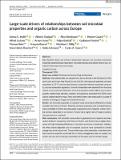Por favor, use este identificador para citar o enlazar a este item:
http://hdl.handle.net/10261/286148COMPARTIR / EXPORTAR:
 SHARE SHARE
 CORE
BASE CORE
BASE
|
|
| Visualizar otros formatos: MARC | Dublin Core | RDF | ORE | MODS | METS | DIDL | DATACITE | |

| Título: | Large-scale drivers of relationships between soil microbial properties and organic carbon across Europe |
Autor: | Smith, Linnea C.; Orgiazzi, Alberto; Eisenhauer, Nico; Cesarz, Simone; Lochner, Alfred; Jones, Arwyn; Bastida, F. CSIC ORCID; Patoine, Guillaume; Reitz, Thomas; Buscot, François; Rillig, Matthias C.; Heintz-Buschart, Anna; Lehmann, Anika; Guerra, Carlos A. | Palabras clave: | Climate change Croplands Europe Land cover Soil carbon Soil microbial biomass Soil microbial respiration Structural equation modelling |
Fecha de publicación: | oct-2021 | Editor: | John Wiley & Sons | Citación: | Global Ecology and Biogeography 30(10): 2070-2083 (2021) | Resumen: | [Aim] Quantify direct and indirect relationships between soil microbial community properties (potential basal respiration, microbial biomass) and abiotic factors (soil, climate) in three major land-cover types. [Location] Europe. [Time period] 2018. [Major taxa studied] Microbial community (fungi and bacteria). [Methods] We collected 881 soil samples from across Europe in the framework of the Land Use/Land Cover Area Frame Survey (LUCAS). We measured potential soil basal respiration at 20 ºC and microbial biomass (substrate-induced respiration) using an O2-microcompensation apparatus. Soil and climate data were obtained from the same LUCAS survey and online databases. Structural equation models (SEMs) were used to quantify relationships between variables, and equations extracted from SEMs were used to create predictive maps. Fatty acid methyl esters were measured in a subset of samples to distinguish fungal from bacterial biomass. [Results] Soil microbial properties in croplands were more heavily affected by climate variables than those in forests. Potential soil basal respiration and microbial biomass were correlated in forests but decoupled in grasslands and croplands, where microbial biomass depended on soil carbon. Forests had a higher ratio of fungi to bacteria than grasslands or croplands. [Main conclusions] Soil microbial communities in grasslands and croplands are likely carbon-limited in comparison with those in forests, and forests have a higher dominance of fungi indicating differences in microbial community composition. Notably, the often already-degraded soils of croplands could be more vulnerable to climate change than more natural soils. The provided maps show potentially vulnerable areas that should be explicitly accounted for in future management plans to protect soil carbon and slow the increasing vulnerability of European soils to climate change. |
Versión del editor: | https://doi.org/10.1111/geb.13371 | URI: | http://hdl.handle.net/10261/286148 | DOI: | 10.1111/geb.13371 | ISSN: | 1466-822X | E-ISSN: | 1466-8238 | Referencias: | Smith, Linnea C.; Orgiazzi, Alberto; Eisenhauer, Nico; Cesarz, Simone; Lochner, Alfred; Jones, Arwyn; Bastida, F.; Patoine, Guillaume; Reitz, Thomas; Buscot, François; Rillig, Matthias; Heintz-Buschart, Anna; Lehmann, Anika; Guerra, Carlos A.; 2021; Large-scale drivers of relationships between soil microbial properties and organic carbon across Europe [Dataset]; Dryad; https://doi.org/10.5061/dryad.g4f4qrfqn |
| Aparece en las colecciones: | (CEAB) Artículos |
Ficheros en este ítem:
| Fichero | Descripción | Tamaño | Formato | |
|---|---|---|---|---|
| soil_microbial_properties.pdf | 1,44 MB | Adobe PDF |  Visualizar/Abrir |
CORE Recommender
SCOPUSTM
Citations
29
checked on 21-abr-2024
WEB OF SCIENCETM
Citations
27
checked on 20-feb-2024
Page view(s)
39
checked on 15-may-2024
Download(s)
24
checked on 15-may-2024
Google ScholarTM
Check
Altmetric
Altmetric
Este item está licenciado bajo una Licencia Creative Commons



